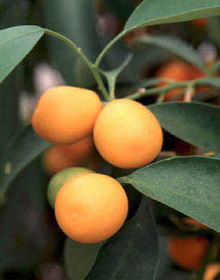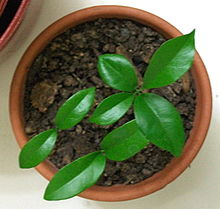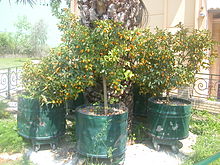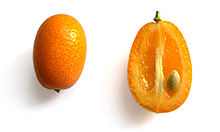- Kumquat
-
Kumquat 
Malayan Kumquat foliage and fruit Scientific classification Kingdom: Plantae (unranked): Angiosperms (unranked): Eudicots (unranked): Rosids Order: Sapindales Family: Rutaceae Subfamily: Aurantioideae Tribe: Citreae Genus: Citrus Species: C. japonica Binomial name Citrus japonica
Thunb.Cumquats or kumquats are a group of small fruit-bearing trees in the flowering plant family Rutaceae, either forming the genus Fortunella, or placed within Citrus sensu lato. The edible fruit closely resembles that of the orange (Citrus sinensis), but it is much smaller and ovular, being approximately the size and shape of an olive.
They are slow-growing evergreen shrubs or short trees, from 2.5 to 4.5 metres (8 to 15 ft) tall, with sparse branches, sometimes bearing small thorns. The leaves are dark glossy green, and the flowers white, similar to other citrus flowers, borne singly or clustered in the leaf-axils. The kumquat tree produces 30 to 50 fruit each year.[dubious ] The tree can be hydrophytic, with the fruit often found floating on water near shore during the ripe season.[citation needed]
The plant is native to south Asia and the Asia-Pacific. The earliest historical reference to kumquats appears in literature of China in the 12th century. They have long been cultivated in Japan, Taiwan, the Philippines and southeast Asia. They were introduced to Europe in 1846 by Robert Fortune, collector for the London Horticultural Society, and shortly thereafter into North America.
Contents
Classification
Carl Peter Thunberg originally classified the kumquats as Citrus japonica in his 1784 book Flora Japonica. In 1915, Walter T. Swingle reclassified them in a segregate genus, Fortunella, named in honor of Robert Fortune. 6 species of Fortunella have generally been recognised — F. japonica, F. margarita, F. crassifolia, F. hindsii, F. obovata and F. polyandra. The Flora of China returns the kumquat to Citrus and combines the species into the single species Citrus japonica.[1]
Varieties
Round kumquat
The Round Kumquat (also Marumi Kumquat or Morgani Kumquat) is an evergreen tree, producing edible golden-yellow colored fruit. The fruit is small and usually round but can be oval shaped. The peel has a sweet flavor but the fruit has a sour center. The fruit can be eaten cooked but is mainly used to make marmalade and jelly. It is grown as an ornamental plant and can be used in bonsai. This plant symbolizes good luck in China and other Asian countries, where it is sometimes given as a gift during the Lunar New Year. It's more commonly cultivated than most other kumquats as it is cold tolerant. It can be kept as a houseplant.
When the kumquats are divided into multiple species the name Fortunella japonica (Citrus japonica) is retained by this group.
Oval kumquat
Description
Fortunella margarita, also known as the oval kumquat or the Nagami kumquat, is a close relative to Citrus species. It is a small evergreen tree, that can reach more than 12 ft (4 m) high and 9 ft (3 m) large. It is native to southeastern Asia, and more precisely to China. The oval kumquat has very fragrant citrus-like white flowers, and small edible oval orange fruits. The oval kumquat is an ornamental little tree, with showy foliage, flowers and fruits. It is also fairly frost-hardy, and will withstand negative temperatures such as 14 °F (-10 °C), and even a little lower for very brief periods. It can be grown in USDA hardiness zones 9 and warmer, but can also be tried in sheltered places, in USDA hardiness zone 8. Unlike most citrus species, the oval kumquat has a shorter growth period, and goes into dormancy fairly earlier in autumn. This partly explains its better frost hardiness.
Characteristics
The evergreen leaves of the oval kumquat are deep-green and relatively small. They can reach up to 3 in (7 cm) long and 1.5 in (3.5 cm) wide. The white flowers of the oval kumquat are similar to the citrus flowers. They are strongly perfumed, and they appear relatively late in the growing season, generally late spring.
The oval kumquat is a fruit that looks like any citrus fruit, with an orange rind. The fruits are oblong, up to 2 in (5 cm) long. Unlike the common citrus, which have a rind which is inedible raw, oval kumquats have an edible sweet rind. The flesh, however, is not as sweet as the rind, and the juice is quite acidic and sour, with a lemon-like flavor. This fruit is generally eaten fresh, with its rind. It can also be processed into preserves, jams, and other products.
Cultivation
The oval kumquat needs a well-drained and fertile ground. It dislikes alkaline soils. The oval kumquat is susceptible to common citrus pests and diseases.[2]
Jiangsu kumquat
The Jiangsu Kumquat or Fukushu Kumquat bears edible fruit that can be eaten raw. The fruit can be made into jelly and marmalade. The fruit can be round or bell shaped, it's bright orange when fully ripe. It may also be distinguished from other kumquats by its round leaves that make this species unique within the genus. It is grown for its edible fruit and as an ornamental plant. It cannot withstand frost.
When the kumquats are divided into multiple species the name Fortunella obovata (Citrus obovata) is used for this group.
Cultivation and uses
Kumquats are cultivated in China, South Korea, North Korea, Taiwan, Southeast Asia, Japan, the Middle East, Europe (notably Corfu, Greece), southern Pakistan, and the southern United States (notably Florida, Louisiana, Alabama) and California.
They are much hardier than other citrus plants such as oranges. The 'Nagami' kumquat requires a hot summer, ranging from 25 °C to 38 °C (77 ° to 100 °F), but can withstand frost down to about −10 °C (14 °F) without injury. They grow in the tea hills of Hunan, China, where the climate is too cold for other citrus fruits, even the Mikan (also known as the Satsuma) orange. The trees differ also from other citrus species in that they enter into a period of winter dormancy so profound that they will remain in it through several weeks of subsequent warm weather without putting out new shoots or blossoms. Despite their ability to survive low temperatures, kumquat trees grow better and produce larger and sweeter fruits in warmer regions.
Uses
Kumquats are often eaten raw. As the rind is sweet and the juicy centre is sour, the raw fruit is usually consumed either whole—to savour the contrast—or only the rind is eaten. The fruit is considered ripe when it reaches a yellowish-orange stage and has just shed the last tint of green.
Culinary uses include candying and kumquat preserves, marmalade, and jelly. Kumquats can also be sliced and added to salads. In recent years kumquats have gained popularity as a garnish for cocktail beverages, including the martini as a replacement for the more familiar olive. A kumquat liqueur mixes the fruit with vodka or other clear spirit. Kumquats are also being used by chefs to create a niche for their desserts and are common in European countries.
Potted kumquat trees at a kumquat liqueur distillery in Corfu.
The Cantonese often preserve kumquats in salt or sugar. A batch of the fruit is buried in dry salt inside a glass jar. Over time, all the juice from the fruit is diffused into the salt. The fruit in the jar becomes shrunken, wrinkled, and dark brown in colour, and the salt combines with the juice to become a dark brown brine. A few salted kumquats with a few teaspoons of the brine/juice may be mixed with hot water to make a remedy for sore throats.[citation needed] A jar of such preserved kumquats can last several years and still keep its taste.[citation needed]
In the Philippines and Taiwan, kumquats are a popular addition to green tea and black tea, either hot or iced.
In Vietnam, kumquat bonsai trees (round kumquat plant) are used as a decoration for the Tết (Lunar New Year) holiday. Kumquat fruits are also boiled or dried to make a candied snack called mứt quất.
Variants of the kumquat are grown specially in India.
Composition
The essential oil of kumquat peel contains much of the aroma of the fruit, and is composed principally of limonene, which makes up around 93% of the total.[3] Besides limonene and alpha-Pinene (0.34%), both monoterpenes, the oil is unusually rich (0.38% total) in sesquiterpenes such as α-bergamotene (0.021%), caryophyllene (0.18%), α-humulene (0.07%) and α-muurolene (0.06%), and these contribute to the spicy and woody flavour of the fruit. Carbonyl compounds make up much of the remainder, and these are responsible for much of the distinctive flavour; these compounds include esters such as isopropyl propanoate (1.8%) and terpinyl acetate (1.26%); ketones such as carvone (0.175%); and a range of aldehydes such as citronellal (0.6%) and 2-methylundecanal. Other oxygenated compounds include nerol (0.22%) and trans-linalool oxide (0.15%).[3]
Etymology
The English name "kumquat" derives from the Cantonese word gam1 gwat1 (given in Jyutping romanization; Chinese: 金橘; pinyin: jīnjú; literally "golden orange"). Cantonese speakers more often write the word today as 柑橘, also pronounced gam1 gwat1 (gān jú in Mandarin, literally "little tangerine orange").
Names in other Asian languages include:
- Japanese: kinkan (金柑)
- Korean: geumgyul (금귤, 金橘)
- Hokkien: gīm-gam (Chinese: 金柑)
- Mandarin: jīnjú (金橘)
- Nepali: muntala
- Thai: somchíd (ส้มจี๊ด)
- Vietnamese: at least three dialect terms are used. In southern Vietnam the fruit is generally known as tắc, in central Vietnam as kim quất, and in northern Vietnam as quất (for Round Kumquat) (not be confused with the bird named "quốc" or "cuốc") and quất ngọt (for Oval Kumquat).
Hybrids
Hybrid forms of the kumquat include the following.
- Limequat - lime + kumquat
- Orangequat - Satsuma mandarin + kumquat
- Calamondin - tangerine + kumquat
- Citrangequat - citrange + kumquat
- Mandarinquat - mandarin + kumquat
- Procimequat - limequat + kumquat
- Sunquat - lemon + kumquat
- Yuzuquat - yuzu + kumquat
Though loquats are not related botanically to kumquats, the terms originate in the same Chinese word designating "orange."
Notes
- ^ Zhang Dianxiang, Thomas G. Hartley, David J. Mabberley, Rutaceae in Flora of China 11: 51-97 (2008)
- ^ Fortunella margarita: oval kumquat, Nagami kumquat, coolexotics.com
- ^ a b Koyasako, A, A.; Bernhard, R.A. (1983). "Volatile Constituents of the Essential Oil of Kumquat". Journal of Food Science (Wiley & Sons) 48 (6): 1807–1812. doi:10.1111/j.1365-2621.1983.tb05090.x. http://www3.interscience.wiley.com/journal/119541583/abstract.
External links
- Burkill, I. H. (1931). An enumeration of the species of Paramignya, Atalantia and Citrus, found in Malaya. Gard. Bull. Straits Settlem. 5: 212–220.
- Mabberley, D. J. (1998). Australian Citreae with notes on other Aurantioideae (Rutaceae). Telopea 7 (4): 333-344. Available online (pdf).
- Fruits of warm climates
- Fortunella crassifolia Swingle - Fruits and Seeds Flavon's Wild herb and Alpine plants
- Fortunella at Wikispecies
- [1] International Code of Botanical Nomenclature (Tokyo Code), Electronic version
- [2] 21. CITRUS Linnaeus, Sp. Pl. 2: 782. 1753. 柑橘属 gan ju shu Zhang Dianxiang (张奠湘); David J. Mabberley
- [3] Carl Peter Thunberg: Flora Japonica
Categories:- Fortunella
- Citrus
- Fruits originating in Asia
- Flora of East Asia
- Flora of Southeast Asia
- Flora of China
- Flora of Hong Kong
- Flora of the Philippines
- Vietnamese ingredients
- Puerto Rican ingredients
- Garden plants of Asia
- Ornamental trees
Wikimedia Foundation. 2010.





